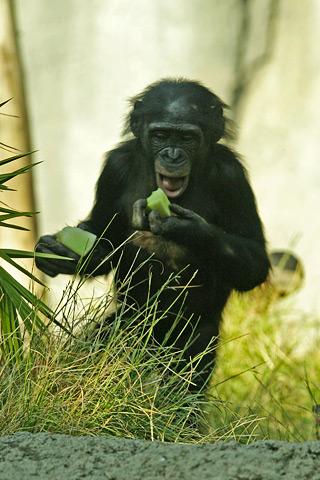Bonobo language
Interview with
From just a few months of age, human babies are able to produce sounds that are the building blocks for the language that we later develop. Scientists had believed that this is a uniquely human trait. But now, Dr Zanna Clay from the University of Birmingham, has found that our closest living relatives - the bonobos - also communicate with each other using "peep" sounds, the meanings of which are determined by context. Amy Goodfellow took a peep at the paper...
building blocks for the language that we later develop. Scientists had believed that this is a uniquely human trait. But now, Dr Zanna Clay from the University of Birmingham, has found that our closest living relatives - the bonobos - also communicate with each other using "peep" sounds, the meanings of which are determined by context. Amy Goodfellow took a peep at the paper...
Zanna - Although speech is unique to humans, the building blocks of speech were probably already present before we became human. And actually, our close relatives, the bonobos, show an ability that is essential for speech to develop.
Amy - Would that mean that maybe bonobos might go on to have more complex conversation or more complex speech like humans do?
Zanna - It's difficult to answer that. We know that there's probably a lot more complexity already existing in the way that these peeps are used. And for example, we've already found in another study that the peeps are combined with other calls and that the combination of the calls in sequences actually creates new meaning for the peeps. And this is something that's really interesting when we're thinking about language and speech evolution because we have what's called syntax in human speech - which is complex combinations of different sounds to create new meanings such as the speech sounds in words. And so, I think, we need to first look at how complex the peep system is before we can make any sort of assessments of what might happen in the future. But it does seem that the peep probably became more flexible and more complex in its use over time, and it probably started out more like a traditional fixed call.
Amy - What does the bonobo's peep actually sound like?
Zanna - So, bonobo peeps sound often like what you might think of as very high pitched bird or a squeaky door. They're really, really high pitched, very short little calls. In fact, in the jungle, sometimes I can't distinguish them very well from bird calls. So, they really are very "peepy" ... and actually high pitched calls require a bit more vocal control, so that's another thing that we think is interesting about peeps. It's harder to control high pitched vocalizations compared to them.
Amy - And from all of your experience in watching the bonobos, are you able to tell what they're saying explicitly?
Zanna - Well, I mean, I have a much better sense of it. Yes. Because they're not just producing peeps, they're producing many, many other different calls. And from my many years of working with bonobos in different situations, I've become a lot more connected to what they're doing and what they might be experiencing. So, by hearing and understanding vocalizations, you can get a really good window into what's going on in there. Sort of, you know, their social lives actually. And so, I find that by listening to calls as a sort of a specialist now, I can often work out roughly what's going on in their experience.
Amy - So, what kind of things do they use these peeps to mean?
Zanna - Well. I mean, they peep in really every context that you can imagine a bonobo experiencing. But they particularly peep in socially important events. So, they peep a lot during feeding and during food discovery, they peep actually when they're grooming, and when they're preparing their nests at night, they peep when they're just about to start travelling, or sometimes when they've stopped travelling, and they peep also during play and aggression, and even during sex. So, it seems any sort of relevant event for them, they like to peep about it.
Amy - Does this give us any information about speech in humans? For example, when we're babies and they make sounds that seem to be similar to peeps in my mind.
Zanna - Yes. I think it does provide us some interesting connections actually with speech development in babies because even before babies can speak or babble, actually. The study was done on babies that are less than four months old. Babies are actually able to produce these signals across all across different emotional situations. And although people often think of babies as just crying and responding to emotions all of the time, when the researchers actually looked at what babies are doing, they realized that the babies, even at this young age, can actually produce these very flexible calls that don't tie so strongly to emotion and probably form the really important foundations and building blocks of their future speech. And the ability for these babies to produce sounds that are freed up from their emotional content.
- Previous What is graphene?
- Next Why cats have vertical slit pupils










Comments
Add a comment